ICD-10-CM Conventions Guidlines 2024
Hello friends , In this article, we will give you complete information about ICD-10-CM conventions guidelines 2024, like while doing any one, we will see which keyword use during coding according to which guideline and i will explain you in detail about each guideline like such as See ,See also ,exclude1, exclude 2 uses use of And etc. This Article is very important for those who prepare for certification courses of medical coding .
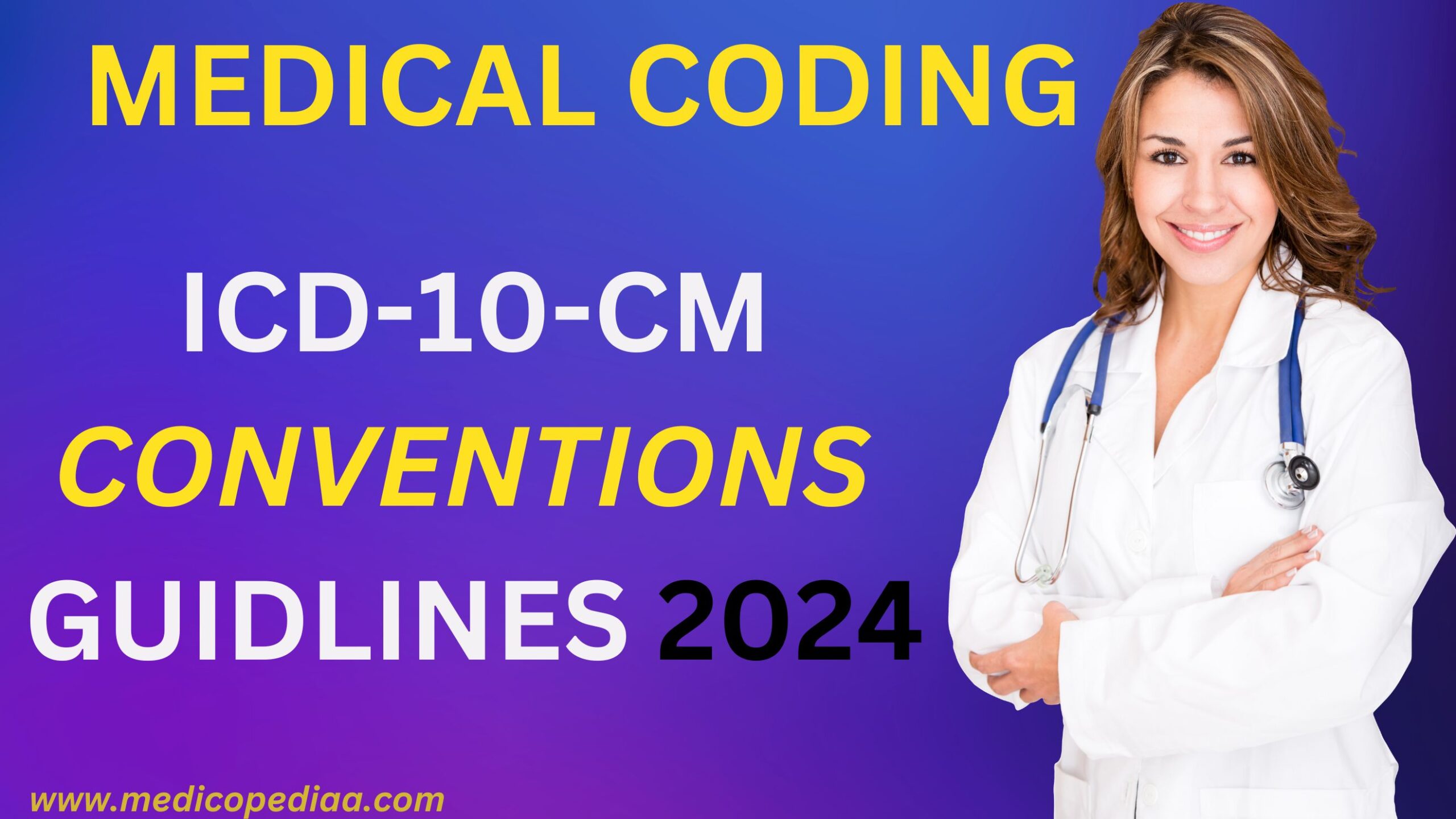
CMS and NCHS provide guidelines for coding ICD-10-CM codes which is correct and correct sequencing.
ICD 10 CM Guidelines have been approved by four department :-
- AHA (American Hospital Association)
- AHIMA (American Health Information Association)
- CMS (Centers for Medicare & Medicaid Services)
- NCHS (National Center for Health Statistics)
The conventions for the ICD-10-CM are the general rules for the classification, independent of the guidelines.These convention are incorporated within the alphabet index and tabular list of the ICD-10-CM as instructional notes.
1.Alphabet index and Tabular list in ICD-10-CM:
The ICD-10-CM is divided into two alphabetic index and tabular list.
Alphabetic index : An alphabetical list of terms and their corresponding codes.
The alphabetic index consists of following parts:
-
Index of disease and injury.
-
Index of external cause of injury
-
Table of neoplasm
-
Table of drug and chemicals
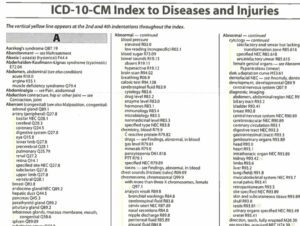
Tabular list: A structured list of codes divided into chapters based on body systems or conditions.
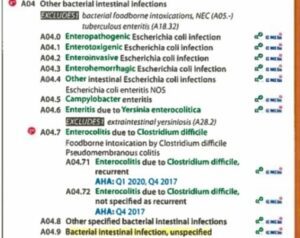
2. Format and structure in ICD-10-CM
The ICD-10-CM tabular list contains categories, subcategories and codes.
- Characters for categories, subcategories and codes may be either a letter or a number.
- Categories are 3 characters – if a three character category has no further subdivision it is equivalent to a code.
- Subcategories are either 4 or 5 characters codes – each level of subdivision after a category is subcategory.
- Codes can be 3,4,5,6 or 7 characters – All codes must be assigned to the highest subdivision or it would not be considered a code.
3.Use of code for reporting purpose in ICD-10-CM
For reporting purpose only code are permissible, not category or subcategory, and any applicable 7th character is required.
4. Placeholder character in ICD-10-CM
The ICD-10-CM utilizes a placeholder character “X”. The “X” is used as a placeholder at certain codes to allow for future expansion.
The letter “X” has two uses:
- As the fifth character for certain sixth character codes.
- The ‘X’ provide for future expansion without disturbing the sixth character structure.
Example of place holder: T36.0X5
2. When the code has less than six characters and seven characters required.
Then X is assigned for all characters less than six in order to meet the requirements of coding the highest level of specificity.
Example of placeholder: O65.0XX1
5. 7th character in ICD-10-CM
1. Provide specific information regarding the clinical visit.
2. The addition of 7th character – Used in certain chapters to provide information about the characteristics of the encounter.
3. Must always be in the 7th character position.
4. If a code has 7th character,. The code must be reported with an appropriate 7th character value in order to be valid.
5. If the 7th character code lack 5th or 6th character, fill them with “X” which is called as placeholder
6. 7th character for injuries and external causes.
A – Initial encounter
D – Subsequent encounter
S – Sequella
7th character for fractures (chapter-19)
A – initial encounter for closed fracture
B – initial encounter for open fracture
D – subsequent encounter for fracture with routine healing
G – subsequent encounter for fracture with delayed healing
K – subsequent encounter for fracture with non- union
P – subsequent encounter for fracture with malunion
S – sequella
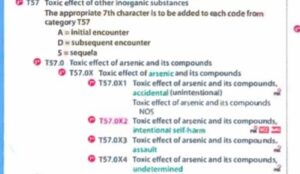
Example of 7th character
S52.244A – nondisplaced spiral fracture of shaft of ulna, right arm, initial encounter.
S – injury chapter
5 – major body region
2 – major nature of injury
244 – specific details on body region and major of injury
A – type of encounter
Example of 7th character
S41.031A – puncture wound without foreign body of right shoulder, initial encounter.
S – injury chapter
4 – should and upper arm
1 – open wound
0 – shoulder
3 – puncture wound without foreign body
1 – laterality
A – initial encounter
6. Abbreviations Used in ICD 10 CM
What is NEC in ICD code ?
NEC(not elsewhere classifiable) – NEC is other specified condition, where more specific condition has been documented by physician but we don’t have code in our book usually these conditions we will codes other specified code ends with 8 in any code.
Example of NEC in ICD-10-CM
N30.8 – other cystitis
H26.8 – other specified cataract
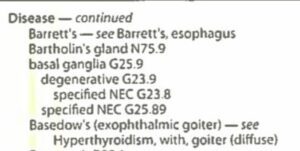
What is NOS in ICD code ?
NOS ( not otherwise specified) – It means we have more specific code but physician didn’t tell us specific condition such as we have stage codes for chronic kidney disease 1 to 6 but if physician didn’t documented stage then we should code unspecified code.
Example of NOS in ICD-10-CM
N30.9 – cystitis, unspecified
H26.9 – cataract, unspecified
E66.9 – obesity, unspecified
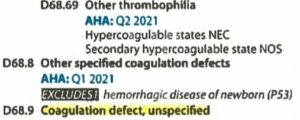
7. Punctuation in ICD-10-CM
Brackets [ ] – Synonyms, alternative words or explanatory phases in tabular list.
Manifestation codes in alphabetic index
Manifestation codes are included in the alphabetic index by including a second code , shown in brackets [ ] directly after the underlying or etiology code which should always be reported first.
Example of brackets [ ] in ICD-10-CM :
Alzheimer’s G30.9 [F02.80]
F02.80 – dementia in disease classified elsewhere without behavioral disturbance.

Paranthesis( ) :-
Supplementary words/non essential modifier in alphabetic index and tabular list.
The term within the parentheses are referred to as nonessential modifiers. The nonessential modifiers in the alphabetic index to disease apply to sub terms following a main term except when a nonessential modifier and sunentry takes precedence.
Enclose supplementary words that may or may not be present in statement of disease without affecting code number assignment.
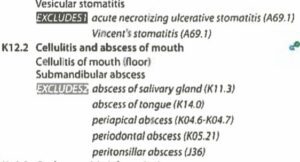
Example of parentheses in ICD-10-CM :
Edema, edematous(infectious) (pitting) (toxic) R60.9
Staphylitis (acute) (chronic) (catarrhal) (gangrenous) (suppurative) (ulcerative) K12.2
Colons ( : ) – Colon are used in tabular list after an incomplete term which need one or more of the modifier following to make it assignable to a given category.
It is used in both includes and excludes notes.
Example of colon in ICD-10-CM
G73.7 myopathy in diseases classified elsewhere
Excludes1: myopathy in:
Rheumatoid arthritis (M05.32)
Systemic lupus erythematous (M32.19)
8. use of ‘and’ in ICD-10-CM
The word “and” should be interpreted to mean either “and” or “or” when it appears in a title.
Example of AND in ICD-10-CM
Cases of tuberculosis of bone ,” tuberculosis of joints and tuberculosis of bones but tuberculosis of joints and bones are classified to subcategory A18.0.
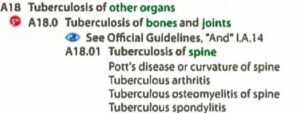
9. Other and unspecified codes in ICD-10-CM
Other codes :
Codes titled “other specified are for use when the information in medical record provides details for which a specific code does not exist.
Alphabetic index entries with NEC in the line designate other codes in the tabular list. These alphabetic index entries represent specific disease entities for which no specific code exists. So the term is included within an other codes.
Example of other specified in ICD-10-CM
Other specified anemia D64.89
Other specified cough R05.8
Other viral entities A08.39

Unspecified codes:
Codes titled “unspecified” are for use when the information in the medical record is insufficient to assign a more specific code. For those categories for which an unspecified code is not provided the other specified code may represent both other and unspecified.
Example of unspecified:
Anemia unspecified D64.9
Sepsis unspecified organism A41.9
Cerebral infraction unspecified I63.9
For CPT Guidlines : https://medicopediaa.com/category/cpt-guidlines/
10. Includes in ICD-10-CM:
If physician mention two diseases and when we search ICD code and under the description of ICD code other disease is include in that case we need to only use one code.
Example of includes in ICD-10-CM:
K45 other abdominal hernia
INCLUDES abdominal hernia specified site NEC.
Lumbar hernia
Obturator hernia
Pudendal hernia
Retroperitoneal hernia
Sciatic hernia.
P35 congenital viral diseases
INCLUDES infections acquired in utero or during birth.

11. Excludes Notes in ICD-10-CM:
The ICD-10-CM has two types of exclude notes. Each type of notes has different definition for use but they are all similar in that they indicate that code excluded from each other are independent of each other.
Exclude 1: “not coded here”
Note that the code excluded should never be used at the same time as the code above exclude 1. An exclude 1 is used when two condition cannot occur together such as congenital form versus an acquired form of the same condition.
Indicate that the code identified in a note and code where the note appear cannot be reported together because the two conditions cannot occur together.
Example of Exclude 1 in ICD-10-CM:
1.N28 chronic disorder of kidney and ureter,not elsewhere classified.
N28.0 ischemia and infraction of kidney
Renal artery embolism
Renal artery obstruction
Renal artery occlusion
Renal artery thrombosis
Excludes 1: atherosclerosis of renal artery (extraperitoneal part (I70.1)
Congenital stenosis of renal artery (Q27.1)
Golblatts kidney (I70.1)
2. Benign neoplasm of vertebral column (D16.6)
Excludes1: Benign neoplasm of sacrum and coccyx (D16.8)
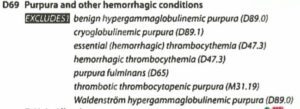
Excludes 2 : Indicate “NOT INCLUDED HERE”
Indicates that a condition identified in the note is not a part of the condition represented by the code where the note appears, So both code may be reported together if the patient has both condition.
It is acceptable to use both the code and any of the excludes 2 codes that appear listed under the code if the patient has the conditions
Example of Excludes 2 in ICD-10-CM :
E85 Amyloidosis
Exclude2 Alzheimer’s disease (G30.0-)

12. Etiology and manifestation convention (“ code first” “use additional codes” and “in disease classified elsewhere “ notes
Etiology in ICD-10-CM :- The cause/ underlying condition.
Manifestation in ICD-10-CM The symptoms are observable condition which are seen as a result of some disease.
The condition is sequenced first, followed by the manifestation:
-
Etiology code will have a use additional note.
-
Manifestation code will have a use code first.
Also usually says”in disease classified elsewhere “
-
Bracket surround the manifestation code in the alpha index.
Code first: If code first documented under any category code then we must first code another code which is directed to code example is severe sepsis where we have to code sepsis where we have to sepsis code first.
Use additional code: here we have to code second code after 1”one.
Example is E11.22 which says to code N18 series additionally .
“Code first” and “use additional code” notes are also used as sequencing rule in the classification of certain codes that are not a part of an etiology/ manifestation combination.

13. “AND” in ICD-10-CM
The word “and” should be interpreted to mean either “and” or “or” when it appears in a title.
Example of AND in ICD-10-CM
Cases of tuberculosis of bone ,” tuberculosis of joints and tuberculosis of bones but tuberculosis of joints and bones are classified to subcategory A18.0.
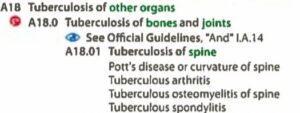
14. “With” in ICD-10-CM
“With” means” associated with” or “due to”
Default is always “without”
Use of with in ICD-10-CM
These condition should be coded as related even in the absence of provider information explicitly Linkin them, unless the documentation clearly states the condition are unrelated or when another guidelines exists that specifically requires a documented linkage between two conditions (e.g sepsis guide for acute organ dysfunction that is not clearly associated with the sepsis”).
For condition not specifically linked by these relational terms in the classification of when a Guidelines requires that a linkage between two conditions be explicitly documented, provider documentation must be linked the conditions in order to code them as related.
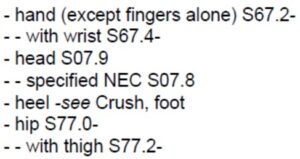
15.“See” and “see also” in ICD-10-CM
See : The”see” instruction following a main term in the alphabetic index indicates that another term should be referenced.
The see instructions following a main term in the alphabetic index indicates that another term should be referenced.
Example of “see” in ICD-10-CM
Keratocele-see descemetocele; descemetocele H18.73-
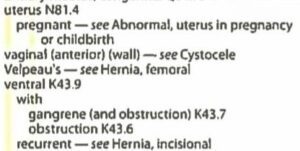
See also : A “see also” instructions following a main term in the alphabetic index instructs that there is another main term that may also be referenced that may provide additional alphabetic index entries that may be useful.
It is not necessary to follow the “see also” note when the original main term provide the necessary code.
Example of see also in ICD-10-CM
Brain herniation ICD
First go alphabetic index and search for herniation.
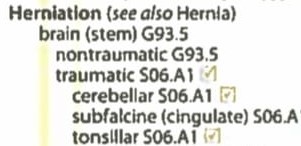
16. “Code also” note in ICD-10-CM
Alerts the coder that more than one code may be required to fully describe the condition.
The sequencing of the codes depends on the severity and/or the reason for the encounter.
Example of code also in ICD-10-CM
I16 hypertensive Crisis
Code also any identified hypertensive disease (I10-I15) (I10-I15.9)
Sequence coded be I16.0, I11.0 or I11.0, I16.0 based on encounter.

17. Default code in ICD-10-CM
A code listed next to main term in the ICD-10-CM alphabetic index is referred to as a default code.
The default code represent that condition that is most commonly associated with the main term or is the unspecified code for the condition.
Example of Default code in ICD-10-CM
Appendicitis is documented without any additional information such as acute or chronic the default should be assigned.
Appendicitis (pneumococcal) (retrocecal) K37-default code without any specification.

18. Code assignment and clinical criteria
The assignment of diagnosis code is based on the provider’s diagnostic statement that the condition exists .
Uses of code assignment and clinical criteria in ICD-10-CM
The provider statement that the patient has a particular condition is sufficient .
Code assignment is not based on clinical criteria used by the provider establish the diagnosis. If there is conflicting medical record documentation, query the provider.
For Any Query : DM me on Instagram – @medico_pediaa
Thanks For Reading this Article.
